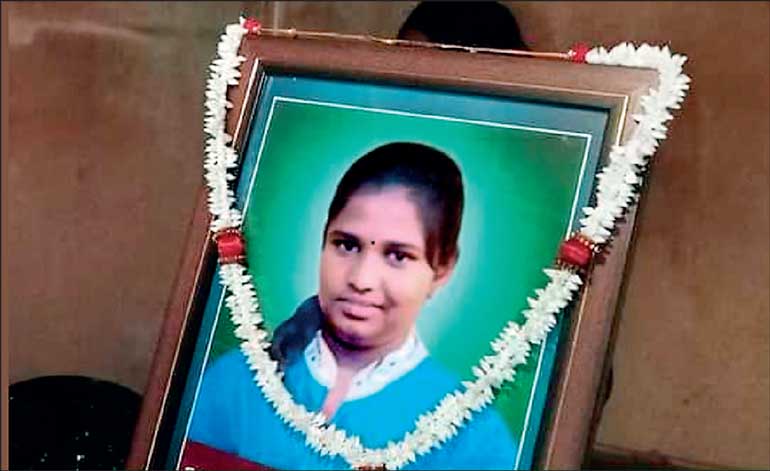Tuesday Apr 22, 2025
Tuesday Apr 22, 2025
Saturday, 7 August 2021 00:10 - - {{hitsCtrl.values.hits}}

Hishalini’s death has provoked agitation among politicians to regulate this market to get rid of under-age employment. Even if legislation to that effect were to be passed, its strict implementation in the prevailing environment of administrative laxity and corruption is questionable
 The tragic death of a 16-year-old housemaid, young Hishalini, which occurred in a Muslim politician’s household has created endless controversies, protest rallies and conspiratorial theories among competing vested interests, and is dragging some parts of the country into a communal frenzy against Muslims.
The tragic death of a 16-year-old housemaid, young Hishalini, which occurred in a Muslim politician’s household has created endless controversies, protest rallies and conspiratorial theories among competing vested interests, and is dragging some parts of the country into a communal frenzy against Muslims.
That incident is now being investigated by security authorities and therefore it is advisable to wait for the findings. If it was a calculated murder, then the full force of law should be allowed to prevail without any political interference. Period.
However, what is lost amidst all this hullabaloo is a public discussion on the underlying cause or causes that drove not only Hishalini, but nearly 103,000 girls and boys, according to one budding politician from the hills, all of whom should otherwise be attending schools at their age, but forced by circumstances to join an army of under-aged employees toiling in the country’s informal sector.
No parent would wish his/her child to sacrifice its happy days in earning and supporting its family. It is the economic condition at home and abject poverty prevailing there that compel thousands of families to send young boys and girls to work in risky industries. Under-age domestic servants are a subset of this growing army. This is one of the darker sides of the country’s open economy.
In a recent report by the World Bank on ‘Informality, Job Quality and Welfare in Sri Lanka,’ it was pointed out that “informal workers have more precarious employment arrangements and inferior working conditions. Their low earning levels elevate the risk of poverty”. Why is the public or the media and politicians not talking about this shameful feature in society?
Of the three major communities in the country, it is the employees in tea and rubber plantations, a subset of the Tamil community, who suffer most from poverty, and it is that community that has become the largest supplier of house maids to the domestic market. How did this come about?
One of the outcomes of JR’s open economy, which has now become a lifesaver to today’s pandemic hit, debt pressed and an almost bankrupt economy, is the export of human resources. It is a cruel choice between exporting goods or people. Economics of neo-liberalism in the 1980s welcomed this choice as solution to chronic unemployment in many developing countries.
Neoliberal economists theorised this phenomenon as a market induced solution for wealth distribution between labour surplus and capital surplus economies. The oil rich Arab Middle East became the chief laboratory to test their thesis. Countless development projects designed chiefly by Western economists, engineers and architects to modernise the medieval desert kingdoms and sheikdoms created a voracious appetite for skilled and unskilled labour, which opened the flood gates for the underpaid and unemployed men and women in developing nations to flock towards the new Eldorado. Sri Lanka too joined the hordes.
In this migration were women, young and old, who went mostly as housemaids to be employed in Arab homes. JR, who was critical in the 1960s and 1970s of Sinhalese women working as housemaids in Muslim homes in Sri Lanka now welcomed them to migrate to Muslim Middle East and remit their earnings in precious dollars.
Among those intellectuals who criticised this Sinhalese-Arab nexus was the foremost playwright, Ediriweera Sarachchandra, who in his Dharmista Samajaya (Colombo: Elko Industries, 1982), addressed and warned of the social evils that would accompany this phenomenon. His views were also voiced by some prominent Buddhist monks. However, given the economic conditions prevailing at home that migration was unstoppable.
What was new in that wave was the inclusion of many young Muslim girls and women. Neither the Muslim politicians of that time nor Muslim religious leaders raised any concern but remained silent and endorsed JR’s initiatives.
The least represented cohort in the housemaid exodus at that time were Tamil women and girls from the plantation sector. This seems to be true even today. Why?
The supply of maids to Middle East is an organised industry riddled with corruption and studded with layers of hurdles to cross before the job seeker reaches her destination. To start with, it needs an initial investment of thousands of rupees which many families do not have but forced to borrow from relatives or friends and money lenders, hoping to pay back with interest later. Such facilities are not easily available to women working in the estate sector. Poverty seems to be their destiny.
Besides, there is also a linguistic inability for these women to speak at least a modicum of English or Arabic to work in an Arab family. As a result, the estate women, unable to make good of the Middle East opportunity, were trapped in the estates. In the meantime, a shortage of domestic servants increased the cost of employing them and wealthy home owners began to look for cheaper sources of supply. The estate sector driven by poverty turned out to be the most dominant source of that supply.
Hishalini’s death has provoked agitation among politicians to regulate this market to get rid of under-age employment. Even if legislation to that effect were to be passed, its strict implementation in the prevailing environment of administrative laxity and corruption is questionable.
Besides, will that legislation solve the problem of poverty in the estate sector? How could a Government that is unable to award even an increase of Rs. 1,000 to those workers hope to alleviate the chronic poverty prevailing in that community? Unless the estate workers receive a decent wage for their labour their children would continue to seek employment in the informal sector.
To the politicians sitting on both sides of the Legislature what matters is the vote bank in the estates. The country saw in 1919 how the Rajapaksa clan used the death of late Arumugam Thondaman as a rallying point for election propaganda, ignoring the threat of corona infection. It seems Hishalini’s death is also becoming a political football between the Government and Opposition.
For over two centuries her community had been selling its labour to keep the Sri Lankan economy growing. In spite all efforts at industrialisation and export diversification, tea is still the largest income earner and contributor to GDP. It is the blood and sweat of estate workers that nourish this industry. Unless the standard of living improves for those worker families, there will be more Hishalinis to mourn for. Politicians should look at the bigger picture behind this girl’s tragedy.
(The writer is attached to the School of Business and Governance, Murdoch University, Western Australia.)
Discover Kapruka, the leading online shopping platform in Sri Lanka, where you can conveniently send Gifts and Flowers to your loved ones for any event including Valentine ’s Day. Explore a wide range of popular Shopping Categories on Kapruka, including Toys, Groceries, Electronics, Birthday Cakes, Fruits, Chocolates, Flower Bouquets, Clothing, Watches, Lingerie, Gift Sets and Jewellery. Also if you’re interested in selling with Kapruka, Partner Central by Kapruka is the best solution to start with. Moreover, through Kapruka Global Shop, you can also enjoy the convenience of purchasing products from renowned platforms like Amazon and eBay and have them delivered to Sri Lanka.
Discover Kapruka, the leading online shopping platform in Sri Lanka, where you can conveniently send Gifts and Flowers to your loved ones for any event including Valentine ’s Day. Explore a wide range of popular Shopping Categories on Kapruka, including Toys, Groceries, Electronics, Birthday Cakes, Fruits, Chocolates, Flower Bouquets, Clothing, Watches, Lingerie, Gift Sets and Jewellery. Also if you’re interested in selling with Kapruka, Partner Central by Kapruka is the best solution to start with. Moreover, through Kapruka Global Shop, you can also enjoy the convenience of purchasing products from renowned platforms like Amazon and eBay and have them delivered to Sri Lanka.